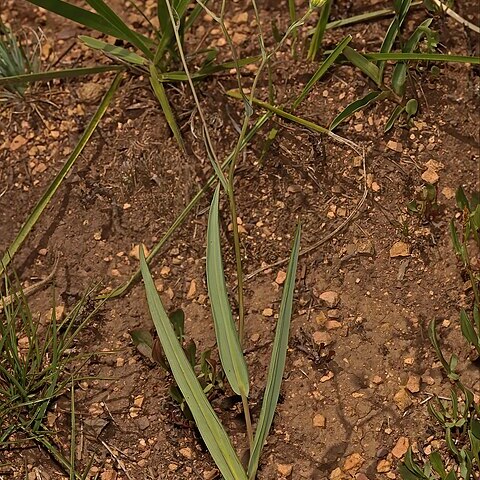Perennial herb; flowering stems up to 0.6 m high from woody stock; glabrous except for woolly crown and woolly hairs hidden in leaf axils; stems solitary, simple below inflorescence branches, leafy mainly in lower part. Leaves: 3-6, passing abruptly into inflorescence bracts; blade linear to very narrowly ovate, up to ± 160 x 40 mm, at least middle leaf (4-)6-10 x or more as long as broad, apex acute to acuminate, base clasping, often minutely eared, sometimes slightly decurrent, margins entire or distantly callose-denticulate, ± revolute, side nerves sharply ascending, glabrous. Heads radiate, many, corymbose-paniculately arranged. Involucral bracts (8-)12(-16), (4-)5-6 mm long, much shorter than disc florets; calyculus bracts 1 or 2, very small. Flowers: ray florets (5, 6)8(10); ray and disc florets bright yellow; Nov., Dec. Fruit with cypsela (and ovary) glabrous.
Perennial herb, glabrous, rootstock woody, crown woolly. Flowering stem solitary, simple, up to 0.6 m high, leafy below. Leaves 3-6, leathery, linear-lanceolate, up to 160 mm long, becoming inflorescence bracts, base ± eared, clasping, margins entire or ± callose-denticulate, ± revolute. Inflorescence corymbose-paniculate; peduncles long. Capitula many, radiate, disc and rays bright yellow, rays mostly 8; involucre turbinate-campanulate; bracts 8-16, 4-6 mm long; calyculus bracts 1 or 2, minute. Flowering time mainly Aug.-Dec. Cypselae cylindrical, 3.5 mm long, ribbed, glabrous.
Perennial herb, up to 0.6 m high. Leaves 3-6, passing abruptly into inflorescence bracts, glabrous except for woolly crown and woolly hairs hidden in leaf axils. Heads radiate, rays 8, rarely 5 or 6, occasionally 10; involucre turbinate-campanulate, bracts (10-) 12-16, (4-)5-6 mm long. Achenes and ovaries glabrous. Flowers bright yellow.

